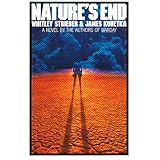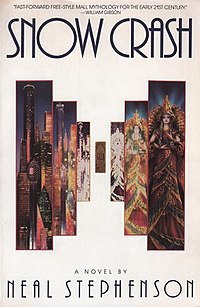


I am sitting at my desk reading the product tour for a software package called PhotoModeler ("Meauring and Modeling the Real World") and I can't help thinking about a Whitley Streiber/James Kunetka thriller I read years ago called "Nature's End" (Schwarzer Horizont in German) and about how all this relates to Bill McKibben's "The End of Nature" which Professor Susanna Hecht assigned us in our urban planning classes at UCLA back at the turn of the century (did nature end with the millenium?).
If I recall Nature's End properly (I read it at the beginning of the 90's) it begins with hero John Sinclair using 3d modeling/animation/simulation software to reconstruct the many possible paths a crime could have followed so that the jury can decide which seems the most plausible. It would seem that Photomodeler sotware is beginning to be used in exactly this fashion. On their own website Eos Systems, the creator of Photomodeler, states,
" PhotoModeler software is used extensively by police, investigators, and forensics firms worldwide. Using photographs or video images taken at the scene, PhotoModeler helps to extract accurate 3D measurements and models quickly and easily, allowing you to analyze and measure crime and accident scenes long after the incident has taken place! ... PhotoModeler has capabilities to help solve even the most advanced accident reconstruction cases."
What is interesting to me is that Streiber writes books of fiction as "simulations" or "models" of events that either have happened, but where it is difficult to establish the true facts surrounding the events (e.g. alien encounters -- a kind of "accident reconstruction case") or could happen (e.g. the kind of future environmental disasters that formed the basis of the Roland Emmerich film "The Day After Tomorrow, inspired by Whitley Streiber and Art Bell's Prophetic "The Coming Global Superstorm", later novelized by Streiber himself.) But while the "1 dimensional" linear narratives found in books can do a decent job of laying out possible paths in a sequential, or serial fashion, and films can do a nice job of fleshing out those paths with rich graphics, real-time interactive 3D simulations based on actual physics and measurement can create the most compelling cases for any given scenario.
This is where a combination of Photomodeler and Google Earth Sketchup and some as yet unchosen Game Engine (like the Havoc Physics Engine, which is not free, or the Blender Game Engine, which is) can produce the desired outcome suggested by Bill McKibben in "The End of Nature".
In his book McKibben offers us two choices (as Led Zeppelin sang in Stairway to Heaven, "yes there are two paths you can go by, but in the long run... there's still time to change the road you're on"). McKibben says we can take the path he calls "The Defiant Reflex" using our technology to macromanage and micromanage the environment so as to reduce its negative effects on us as it degrades, or we can take "The Humble Approach" whereby we give up our dream of "control".
The idea behind our Solar Cities Political Ecology Alternate Reality Game is that we should be able to use software like Photomodeler, Sketchup, Google Earth and Blender to create the kind of simulations John Sinclair could use to defeat dangerous fanatics (like Gupta Singh and George W.) and play them out in the court of humanity in front of an international jury of connected minds who can rationally and democratically vote on and thus choose the paths we take into the future.
I personally believe that McKibben's binary logic is flawed and that both "The Defiant Reflex" and "The Humble Approach" can work in tandem. In fact I think that they will see-saw back and forth, as our greater control over and understanding of the political and environmental ecology of the earth help us lose our fear and give us more confidence in devolving some of our control (if not all of it) to the collective intelligence of the God-Earth-Mind system. Call it "Gaia" or call it "Hive Intelligence" or "Swarm Intelligence", or simply call it "The Invisible Hand" tempered with "Moral Sentiments"; the idea is that we didn't create this system, this earth, this universe, it created us, and we can trust it to do its job of creating and nurturing living systems once we understand where it functions and where it fails (for us!) and how to tweak it, when necessary (as all living beings do) , to try and avoid suffering and extinction.
Perhaps "The Defiant Path" will lead inexorably to "The Humble Approach", much as Marx predicted that Capitalism was a necessary phase on the journey to communal harmony through an "inevitable" socialism. I think the jury is still out on that -- but of course all of these eschatological theories contain deep epistemological flaws in that they all involve definitive "end points" -- a flaw echoed in book titles such as "The End of Nature" and "Nature's End", to say nothing of Fukuyama's "The End of History".
The point today, class, is that a tool such as Photomodeler, and other technologies that let anybody, anywhere easily reconstruct the past or make predictions of the future based on easily obtainable physical evidence in the present, CAN be used for social and environmental good, if we will only orient our thinking that way, and contribute actively to the collective task at hand.






